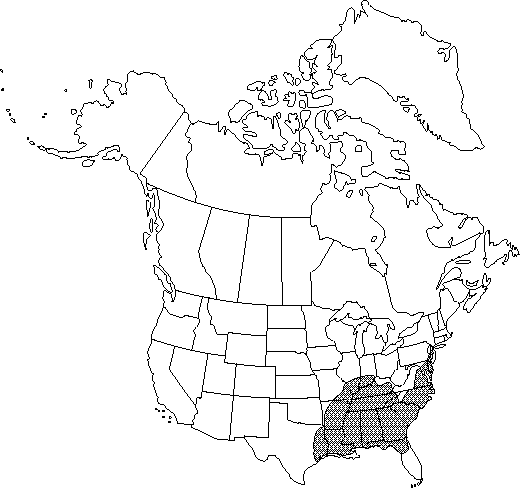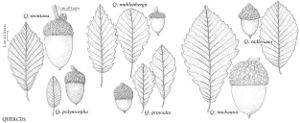Difference between revisions of "Quercus michauxii"
Gen. N. Amer. Pl. 2: 215. 1818.
FNA>Volume Importer |
FNA>Volume Importer |
||
| Line 17: | Line 17: | ||
|basionyms= | |basionyms= | ||
|synonyms={{Treatment/ID/Synonym | |synonyms={{Treatment/ID/Synonym | ||
| − | |name= | + | |name=Quercus houstoniana |
|authority=C. H. Muller | |authority=C. H. Muller | ||
}} | }} | ||
| Line 34: | Line 34: | ||
|elevation=0-600 m | |elevation=0-600 m | ||
|distribution=Ala.;Ark.;Del.;Fla.;Ga.;Ill.;Ind.;Ky.;La.;Md.;Miss.;Mo.;N.J.;N.C.;Pa.;S.C.;Tenn.;Tex.;Va. | |distribution=Ala.;Ark.;Del.;Fla.;Ga.;Ill.;Ind.;Ky.;La.;Md.;Miss.;Mo.;N.J.;N.C.;Pa.;S.C.;Tenn.;Tex.;Va. | ||
| − | |discussion=<p>Quercus michauxii is easily distinguished from other chestnut-leaved oaks by the felty hairs of the abaxial leaf surface and rather large acorn cups with attenuate-acute, loose scales. This species is no longer extant in Oklahoma. Historical reports from Connecticut, Massachusetts, and New York have not been confirmed; possibly populations are no longer extant. (See Quercus montana for a discussion of nomenclature and the uncertain application of the name Q. prinus).</p> | + | |discussion=<p><i>Quercus michauxii</i> is easily distinguished from other chestnut-leaved oaks by the felty hairs of the abaxial leaf surface and rather large acorn cups with attenuate-acute, loose scales. This species is no longer extant in Oklahoma. Historical reports from Connecticut, Massachusetts, and New York have not been confirmed; possibly populations are no longer extant. (See <i>Quercus montana</i> for a discussion of nomenclature and the uncertain application of the name Q. prinus).</p> |
|tables= | |tables= | ||
|references= | |references= | ||
| Line 47: | Line 47: | ||
|rank=species | |rank=species | ||
|parent rank=section | |parent rank=section | ||
| − | |synonyms= | + | |synonyms=Quercus houstoniana |
|basionyms= | |basionyms= | ||
|family=Fagaceae | |family=Fagaceae | ||
| Line 58: | Line 58: | ||
|publication year=1818 | |publication year=1818 | ||
|special status=Endemic;Selected by author to be illustrated | |special status=Endemic;Selected by author to be illustrated | ||
| − | |source xml=https://jpend@bitbucket.org/aafc-mbb/fna-data-curation.git/src/ | + | |source xml=https://jpend@bitbucket.org/aafc-mbb/fna-data-curation.git/src/8f726806613d60c220dc4493de13607dd3150896/coarse_grained_fna_xml/V3/V3_754.xml |
|genus=Quercus | |genus=Quercus | ||
|section=Quercus sect. Quercus | |section=Quercus sect. Quercus | ||
Revision as of 17:19, 18 September 2019
Trees, deciduous, to 20 m. Bark light brown or gray, scaly. Twigs brown or reddish brown, 2-3 mm diam., with sparse spreading hairs or glabrate. Buds reddish brown, ovoid, apex rounded or acute, glabrous or minutely puberulent. Leaves: petiole 5-20 mm. Leaf blade broadly obovate or broadly elliptic, (60-)100-280 × 50-180 mm, base rounded-acuminate or broadly cuneate, margins regularly toothed, teeth rounded, dentate, or acuminate, secondary veins 15-20 on each side, parallel, straight or somewhat curved, apex broadly rounded or acuminate; surfaces abaxially light green or yellowish, felty to touch because of conspicuous or minute, erect, 1-4-rayed hairs, adaxially glabrous or with minute simple or fascicled hairs. Acorns 1-3, subsessile or more often on axillary peduncle to 20-30 mm; cup hemispheric, broadly hemispheric or even short-cylindric, 15-25 mm deep × 25-40 mm wide, enclosing 1/2 nut or more, scales very loosely appressed, distinct to base, gray or light brown, moderately to heavily tuberculate, tips silky-tomentose; nut light brown, ovoid or cylindric, 25-35 × 20-25 mm, glabrous. Cotyledons distinct.
Phenology: Flowering early–late spring.
Habitat: Bottomlands, rich sandy woods and swamps, on variety of soils
Elevation: 0-600 m
Distribution

Ala., Ark., Del., Fla., Ga., Ill., Ind., Ky., La., Md., Miss., Mo., N.J., N.C., Pa., S.C., Tenn., Tex., Va.
Discussion
Quercus michauxii is easily distinguished from other chestnut-leaved oaks by the felty hairs of the abaxial leaf surface and rather large acorn cups with attenuate-acute, loose scales. This species is no longer extant in Oklahoma. Historical reports from Connecticut, Massachusetts, and New York have not been confirmed; possibly populations are no longer extant. (See Quercus montana for a discussion of nomenclature and the uncertain application of the name Q. prinus).
Selected References
None.
